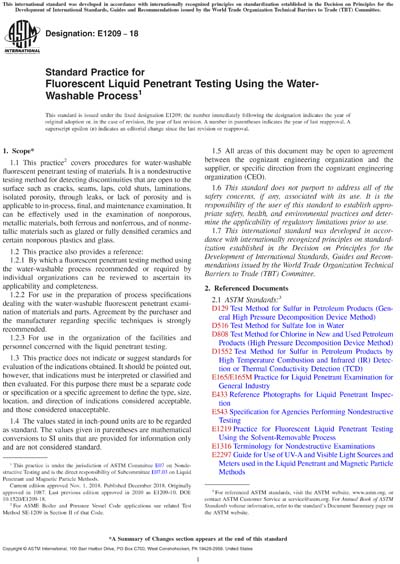Most recent
ASTM E1209-18
Standard Practice for Fluorescent Liquid Penetrant Testing Using the Water-Washable Process
1.1 This practice2 covers procedures for water-washable fluorescent penetrant testing of materials. It is a nondestructive testing method for detecting discontinuities that are open to the surface such as cracks, seams, laps, cold shuts, laminations, isolated porosity, through leaks, or lack of porosity and is applicable to in-process, final, and maintenance examination. It can be effectively used in the examination of nonporous, metallic materials, both ferrous and nonferrous, and of nonmetallic materials such as glazed or fully densified ceramics and certain nonporous plastics and glass.
1.2 This practice also provides a reference:
1.2.1 By which a fluorescent penetrant testing method using the water-washable process recommended or required by individual organizations can be reviewed to ascertain its applicability and completeness.
1.2.2 For use in the preparation of process specifications dealing with the water-washable fluorescent penetrant examination of materials and parts. Agreement by the purchaser and the manufacturer regarding specific techniques is strongly recommended.
1.2.3 For use in the organization of the facilities and personnel concerned with the liquid penetrant testing.
1.3 This practice does not indicate or suggest standards for evaluation of the indications obtained. It should be pointed out, however, that indications must be interpreted or classified and then evaluated. For this purpose there must be a separate code or specification or a specific agreement to define the type, size, location, and direction of indications considered acceptable, and those considered unacceptable.
1.4 The values stated in inch-pound units are to be regarded as standard. The values given in parentheses are mathematical conversions to SI units that are provided for information only and are not considered standard.
1.5 All areas of this document may be open to agreement between the cognizant engineering organization and the supplier, or specific direction from the cognizant engineering organization (CEO).
1.6 This standard does not purport to address all of the safety concerns, if any, associated with its use. It is the responsibility of the user of this standard to establish appropriate safety, health, and environmental practices and determine the applicability of regulatory limitations prior to use.
1.7 This international standard was developed in accordance with internationally recognized principles on standardization established in the Decision on Principles for the Development of International Standards, Guides and Recommendations issued by the World Trade Organization Technical Barriers to Trade (TBT) Committee.
ASTM International [astm]

